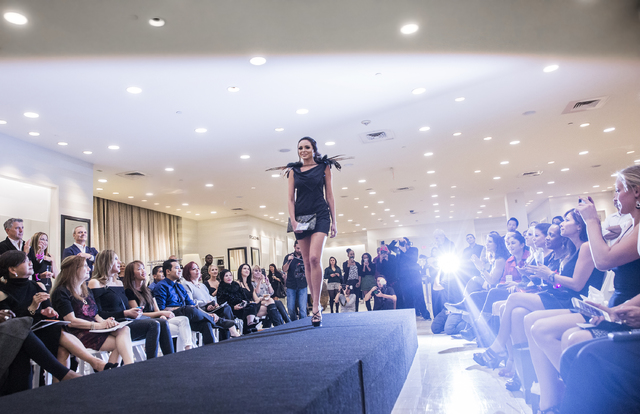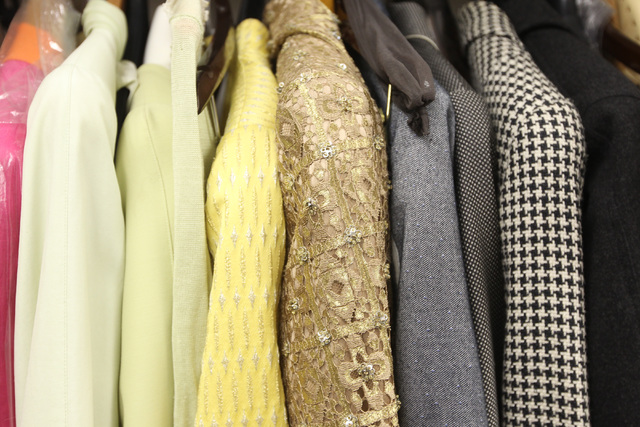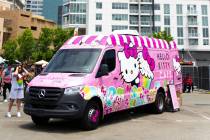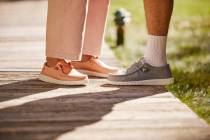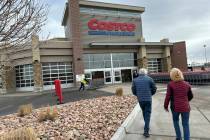Advocates work to place Las Vegas on the fashion map
Corinne Entratter Sidney, 79, has always loved fashion. She’s been a model and actress, and spent three months as a Copa Girl in Las Vegas in the ’60s, before marrying casino manager Jack Entratter.
In the years since, Entratter Sidney has amassed a clothing collection that can only be described as priceless. Very little of her collection was purchased in Las Vegas, she says. “I’d go shopping on Rodeo Drive in Beverly Hills and have it shipped to Nevada.”
That was, of course, long before shopping began to join gambling and shows as reasons people travel to Las Vegas. And although fashion and shopping have made great strides in the Entertainment Capital of the World during the past two decades, Las Vegas still isn’t considered a major industry player.
Yet.
It’s not as far-fetched as it might sound. It was not so long ago that the culinary establishment turned up its nose at the land of the 99-cent shrimp cocktail and all-you-can-eat buffets. But today, the world’s top chefs create some of the most spectacular meals imaginable on those same grounds. Recently, a group of men and women in town have banded together, dedicated to the cause of making the city more fashion forward.
The group established itself as a nonprofit called the Las Vegas Fashion Council, with a stated mission of boosting and expanding the local economy “through the efforts of the fashion industry,” says founder Carrie Carter-Cooper.
Las Vegas is “known as a fashion shopping destination, but we’re not known as a fashion destination,” says Carter-Cooper, a former model and current owner of a modeling agency.
She’s aware of the challenges. “We’ll certainly never be a New York,” she says, but “we’re looking to have Las Vegas be a prominently known city; an incubator, if you will, of fashion designers.” Connecting fashion-minded students to locals already immersed in the local industry is one of the ways the council hopes to expand the fashion market.
STARTING SMALL
This November, in what may have been Las Vegas’ most fashion-filled day of the year, two runway shows were held. The first was Make-A-Wish of Southern Nevada’s annual Fashion Show Luncheon, held at Wolfgang Puck’s Spago in the Forum Shops at Caesars. Fashionably dressed women in full hair and makeup and gentlemen in handmade suits mingled in the crowded restaurant, specialty cocktails in hand, before settling in for lunch as models in Emilio Pucci weaved through the restaurant.
Later that evening, in an intimate corner of Saks Fifth Avenue at Fashion Show mall, camera lights flashed and the audience clapped as students from The Art Institute of Las Vegas made their way down a makeshift runway wearing their own designs. It was the third annual Little Black Dress design competition, hosted by Las Vegas Fashion Council, the group’s largest event of the year. The event benefited the nonprofit council, along with Friends of the Shade Tree, a local shelter for abused women and children.
At the Fashion Focus Forum in October, high school and college students listened to panelists from the local fashion scene speak about opportunities and challenges, as well as brainstorm ways to get ahead of the curve. Students were encouraged to network, find a mentor and follow their passion for fashion. Some were engaged, asking questions about internships within the panelists’ businesses, while others stared down at their phones.
The Fashion Council’s members include 10 students, and Carter-Cooper hopes that number will continue to grow. Many stuggle to come up with the student membership fee, reduced to $35 (the annual fee for an individual is $150).
Student involvement is one way the Fashion Council is trying to build a culture of fashion in Las Vegas, but the nascent organization isn’t well known.
“I didn’t know there was one here!” says Entratter Sidney, also the widow of George Sidney, director of such classic films as “Viva Las Vegas” and “Bye Bye Birdie,”who admits being skepical that Las Vegas has a fashion scene or the need for one. “And dress up to play a slot machine?” she quips.
Las Vegas hasn’t historically been a shopping destination, but that’s changing, according to author and UNLV fashion historian Deirdre Clemente, a historical consultant for Baz Luhrmann’s film “The Great Gatsby.” “I think the shopping in Las Vegas is one of the fundamental cultural changes that’s happened here in the last 20 years.”
As much as shopping options have grown, the numbers of emerging fashion designers and manufacturing hubs remain small, and Clemente cites the mass-shopping culture here as a major roadblock. “One of the biggest problems with developing a major fashion industry here is that we’re so saturated with these powerful outlets and pre-established shopping centers.”
MARKET CHALLENGES
Melissa Akkaway, 38, is a local fashion insider; her great-grandfather opened Beckley’s men’s clothing store that first occupied a canvas tent before moving to what is now the Golden Gate Hotel and Casino in 1908. Akkaway knows firsthand the struggles of finding fashion footing in the valley after opening an on-trend boutique at The Cosmopolitan of Las Vegas and closing it four years later. “It was hard to capture locals because they don’t really like to go to the Strip,” she notes. “It was challenging for me, because I have good local connections, but they don’t really want to travel.”
And the tourists, well, they want everything to be where they are: On the Strip.
“Speaking from a local’s perspective, tourists want to walk outside of their hotel room and find everything at their fingertips without walking a lot,” Akkaway says. And each group — locals and tourists — wants something different. “I think it’s very hard to figure out what the fashion scene is in Las Vegas because it’s always changing.”
As for the tourists, their style runs the gamut from overly casual to distasteful. “You can go see Celine, as much as we absolutely hate it, in shorts and flip-flops,” says Jan Jewett, longtime resident and costumer for iconic Strip shows such as “Folies Bergere” and author of “Liberace Extravaganza!” “Everybody has this little section in their closet, and hung in that little, tiny section is what can be worn in Las Vegas,” Jewett adds. “They wear some stuff here they would never, ever wear anywhere else.”
Carter-Cooper acknowledges that the role tourism plays in the valley economy can make it difficult for Las Vegas to be taken seriously. “People go, ‘It’s Sin City, it’s flashy, it’s gaudy, it’s this, it’s that,’” she says. “It’s so not that.”
Clemente says as the city’s manufacturing sector develops, so will its reputation as a legitimate fashion center. “Las Vegas has an incredible opportunity to become at the heart of the garment industry. … You need a crossroads of transportation coming to you, and you need space,” she notes.
Stitch Factory, in the downtown Arts District, is a local garment business-slash-creative design space that opened in 2012. Similar to backstage at Project Runway, the space is filled with sewing machines and bolts of fabric for local designers to create apparel. In addition to providing a workspace, Stitch Factory also helps budding designers brand their products and prepare them for the marketplace.
Carter-Cooper wants Las Vegas to have its own Fashion Week. “We think we’ve got all the workings of it.”
The only international Vegas event is the MAGIC trade show, which has an impact on the economy that can’t be ignored. MAGIC draws more than 80,000 people to the city twice a year and is the world’s largest fashion trade show. Carter-Cooper doesn’t see this in conflict with a potential Fashion Week, however.
“MAGIC is obviously a commerce situation. Fashion Week would be more about presenting local designers, and some nonlocal ones. It’s an entertainment focus,” she clarifies. With such a huge chunk of the fashion economy in MAGIC, does Carter-Cooper and the LVFC have plans to take advantage of the trade show’s following?
“We currently do not have any ties, but that’s definitely one of our far-reaching goals,” Carter-Cooper says. “We want to make sure they understand that we aren’t trying to take away, we’re trying to add value to what they do.”
Clemente says capitalizing on the image of Las Vegas would be a way to make people take notice of a local Fashion Week. “If you would just accept that you are not in Milan and embrace what you are, people would come just out of curiosity. I think there would be major fashion companies that would do a line for it.”
Contact Brooke Wanser at bwanser@reviewjournal.com. Follow @Bwanser_LVRJ on Twitter.
RELATED
Las Vegas designer explains how she overcame immigration obstacles to launch career







